Photo from SEE Magazine
While flipping through an old copy artSee, a North Carolina arts magazine, during my morning coffee I came across this photo which inspired the question, "I wonder if this man understands what he's looking at?" I ask this question not out of snobbery, but out of experience.
I remember being introduced the abstract paintings of Mark Rothko in college through a framed poster prior to having read anything about moern art. I thought Rothko's work was a complete dud. As a business student at the time, I could not imagine how three, very flat color clouds stacked on top of each other, reproduced in the poster hanging in that Virginia Tech business school lecture hall was considered an artistic achievement, much less worthy of hanging there. I had no way of entry into this primitive and insulting color stack. It was a wall to me. The format of a framed poster within a institute of higher learning presumed in my opinion, significance and achievement. To me, this thing had attained none of the above.
It wasn't until about a year after graduation that I first thumbed through the pages of an art history book on a work break and gave myself to reading about modern art. As most art history books do, this book ordered movements of art chronologically and explained the artists' intentions, including many quotes by the artists themselves, which I found fascinating. Seeing the evolution of visual forms chronologically over the pages and reading the artists' quotes were like a door of understanding opening to me. Visual languages I had never understood were now comprehensible. I began to see art movements as an evolving conversation about visual forms and ideas. From realism, to impressionism, to post-impressionism, to expressionism, to cubism, to pure abstraction, it was all a progressing conversation, and often an extremely heated one. Each subtle transformation of style, presented a chapter in a story and an argument of sorts, and each artist, his and her position in that dialogue. I realized pouring through this book during my work breaks that modern art didn't need to be all an insulting vault to me. I just needed the combination, which came to me mostly lucidly through the artists' mouths. I was hooked. I was hooked to the point that I wanted to participate.
Within a few months of coming across this book, I bought my first set of paints at the ripe age of 22 and I've been painting since, engaging in my own way with the living story line of that conversation. Whether making it, appreciating it, or both, visual art is historically speaking, surely one field for humanity's highest achievements. It's a pleasure I feel fortunate to be able to enjoy and believe everyone can participate. Appreciation through an old magazine alone, certainly makes morning coffee and life rich!


